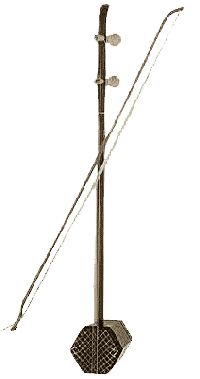 Theerhuis featured regularly in "silk and bamboo" ensembles -- an elaborate but quite accessible form of Chinese folk music, alongside various bamboo wind instruments andplucked strings such as thepipa(lute) andyangqin(dulcimer). Such music is played at village ceremonies and informal "jam sessions" in teahouses. It is also an accompanying instrument in Chinese Opera -- an ancient form of highly stylized musical dramas, and classical music. There are around a dozen close relatives of theerhuwithin China and in other parts of the East. Thebanhu, for example, has a wooden top rather than a snakeskin membrane, and thesihu, from Mongolia, has two pairs of strings with a remarkable double bow with two tiers of hair. The morin khur, also from Mongolia, is a rectangular fiddle with a carved horse head and strings made of thick strands of silk; it produces a deep, guttural sound.
Theerhuis featured regularly in "silk and bamboo" ensembles -- an elaborate but quite accessible form of Chinese folk music, alongside various bamboo wind instruments andplucked strings such as thepipa(lute) andyangqin(dulcimer). Such music is played at village ceremonies and informal "jam sessions" in teahouses. It is also an accompanying instrument in Chinese Opera -- an ancient form of highly stylized musical dramas, and classical music. There are around a dozen close relatives of theerhuwithin China and in other parts of the East. Thebanhu, for example, has a wooden top rather than a snakeskin membrane, and thesihu, from Mongolia, has two pairs of strings with a remarkable double bow with two tiers of hair. The morin khur, also from Mongolia, is a rectangular fiddle with a carved horse head and strings made of thick strands of silk; it produces a deep, guttural sound.
Theerhuis almost always a must in national orchestras. In smaller orchestras, there are usually two to 6erhu; in larger ones there are l0-12. In fact, theerhuplays the same role as the violin in Western orchestras.